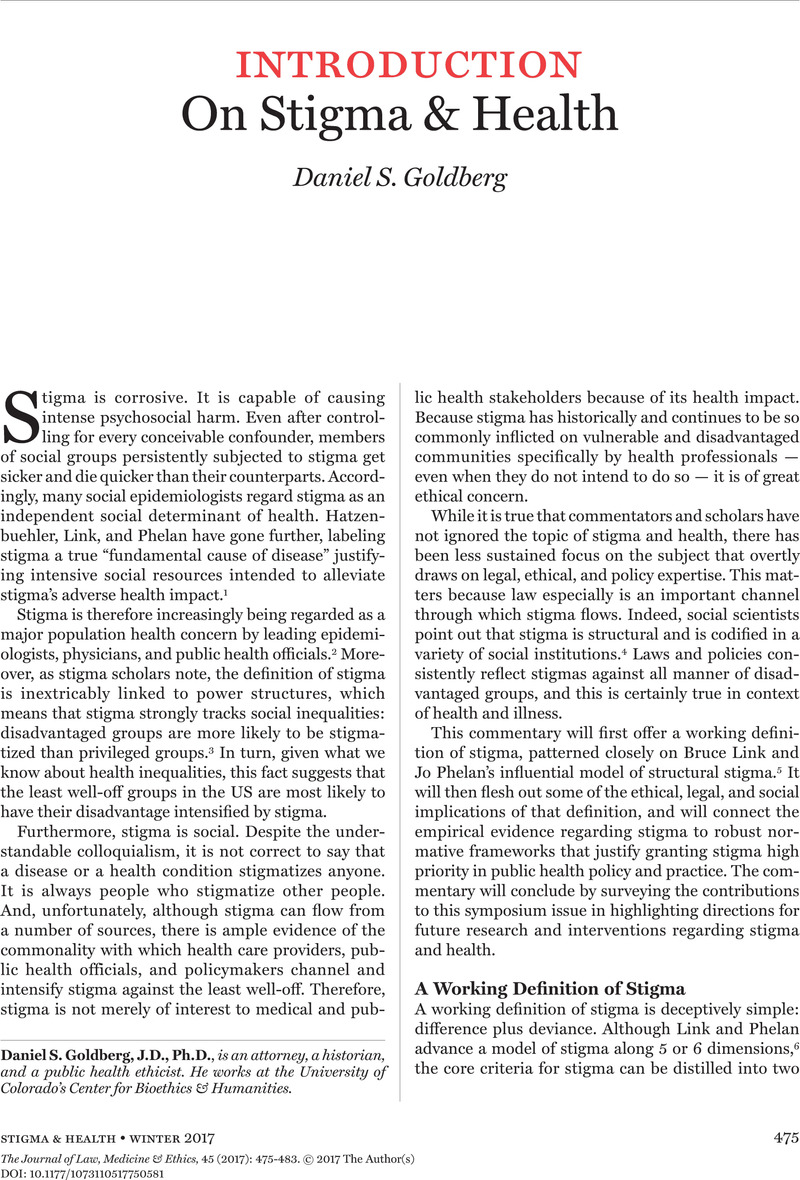Crossref Citations
This article has been cited by the following publications. This list is generated based on data provided by Crossref.
Buller, Mary K.
Andersen, Peter A.
Bettinghaus, Erwin P.
Liu, Xia
Slater, Michael D.
Henry, Kimberly
Fluharty, Lyndsay
Fullmer, Steven
and
Buller, David B.
2018.
Randomized Trial Evaluating Targeted Photographic Health Communication Messages in Three Stigmatized Populations: Physically-Disabled, Senior, and Overweight/Obese Individuals.
Journal of Health Communication,
Vol. 23,
Issue. 10-11,
p.
886.
Terry, Paul E.
2018.
Breaking the Silence and Other Prevention Lessons From the Opioid Epidemic.
American Journal of Health Promotion,
Vol. 32,
Issue. 4,
p.
854.
Goldberg, Daniel S.
2018.
Pain Neuroethics and Bioethics.
Vol. 1,
Issue. ,
p.
85.
Dineen, Kelly K.
2018.
Defining Misprescribing to Inform Prescription Opioid Policy.
Hastings Center Report,
Vol. 48,
Issue. 4,
p.
5.
McCradden, Melissa D.
Vasileva, Denitsa
Orchanian-Cheff, Ani
and
Buchman, Daniel Z.
2019.
Ambiguous identities of drugs and people: A scoping review of opioid-related stigma.
International Journal of Drug Policy,
Vol. 74,
Issue. ,
p.
205.
Serota, Kristie
Bannerman, Grace
Hong, Rachel
and
Buchman, Daniel Z
2020.
News Media Representations of Responsibility for Alcohol-Related Liver Disease Requiring Liver Transplantation.
Canadian Journal of Bioethics,
Vol. 3,
Issue. 3,
p.
62.
Schofield, Casey A.
and
Ponzini, Gabriella T.
2020.
The Skidmore Anxiety Stigma Scale (SASS): A covert and brief self-report measure.
Journal of Anxiety Disorders,
Vol. 74,
Issue. ,
p.
102259.
Goldberg, Daniel S.
2020.
Toward Fair and Humane Pain Policy.
Hastings Center Report,
Vol. 50,
Issue. 4,
p.
33.
Akou, Heather Marie
2020.
Food service uniforms and the symbolism(s) of wearing a mask.
Clothing Cultures
,
Vol. 7,
Issue. 2,
p.
147.
Batyrgareieva, Vladyslava S.
Zaiarnyi, Oleh A.
and
Shramko, Sabriie S.
2020.
PREVENTION OF THE STIGMATIZATION OF INDIVIDUALS IN RESPONSE TO DIGITAL TRACKING (CONCIDERING COVID-19 ISSUE).
Wiadomości Lekarskie,
Vol. 73,
Issue. 12,
p.
2715.
Adams, Sara B.
2021.
Uncovering Hidden Resources: Using Historical Narrative to Teach Social Determinants of Health.
Journal of Nursing Education,
Vol. 60,
Issue. 9,
p.
522.
Meadows, Angela
Daníelsdóttir, Sigrún
Goldberg, Daniel
and
Mercedes, Marquisele
2021.
Fighting for a (wide enough) seat at the table: weight stigma in law and policy.
Fat Studies,
Vol. 10,
Issue. 2,
p.
101.
Goldberg, Daniel S.
2021.
Doubt & Social Policy: The Long History of Malingering in Modern Welfare States.
Journal of Law, Medicine & Ethics,
Vol. 49,
Issue. 3,
p.
385.
Reid, Lynette
2022.
The Language of Incarceration and of Persons Subject to Incarceration.
Public Health Ethics,
Vol. 15,
Issue. 2,
p.
191.
Ballesteros, Virginia
2022.
A stigmatizing dilemma in the labour room: Irrationality or selfishness?.
Journal of Evaluation in Clinical Practice,
Vol. 28,
Issue. 5,
p.
875.
Casper, Stephen T.
2022.
Punch-Drunk Slugnuts: Violence and the Vernacular History of Disease.
Isis,
Vol. 113,
Issue. 2,
p.
266.
Kwok, Kim
and
Kwok Lai Yuk Ching, Sylvia
2022.
Navigating Stigma and Discrimination: Experiences of Migrant Children with Special Needs and Their Families in Accessing Education and Healthcare in Hong Kong.
International Journal of Environmental Research and Public Health,
Vol. 19,
Issue. 10,
p.
5929.
Moses, Tabitha E.H.
Chou, Jody S.
Moreno, Jessica L.
Lundahl, Leslie H.
Waineo, Eva
and
Greenwald, Mark K.
2022.
Long-term effects of opioid overdose prevention and response training on medical student knowledge and attitudes toward opioid overdose: A pilot study.
Addictive Behaviors,
Vol. 126,
Issue. ,
p.
107172.
Labbé, Fabienne
Pelletier, Catherine
Bettinger, Julie A.
Curran, Janet
Graham, Janice E.
Greyson, Devon
MacDonald, Noni E.
Meyer, Samantha B.
Steenbeek, Audrey
Xu, Weiai
and
Dubé, Ève
2022.
Stigma and blame related to COVID-19 pandemic: A case-study of editorial cartoons in Canada.
Social Science & Medicine,
Vol. 296,
Issue. ,
p.
114803.
Aggarwal, Neil Krishan
Chen, Daniel
and
Lewis-Fernández, Roberto
2023.
Eliciting social stressors, supports, and determinants of health through the DSM-5 cultural formulation interview.
Frontiers in Psychiatry,
Vol. 14,
Issue. ,



